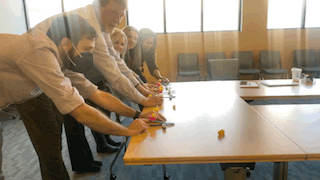Related Articles
Subscribe to the Greater Public newsletter to stay updated.
This site is protected by reCAPTCHA and the Google Privacy Policy and Terms of Service apply.

Times are challenging for public media, with many organizations trying to transform for financial sustainability while facing industry-wide concerns. When leading organizational change—whether through new staff, infrastructure, or digital capabilities—you must do more than just appoint a team and allocate budget. An often overlooked but crucial leadership component is strategically positioning the initiative to align your entire organization with the transformation.
WBUR, Boston’s NPR, recently navigated a significant organizational transformation that can offer some valuable insights for leading through change while managing financial challenges. In 2022, WBUR began the work of transitioning off of legacy systems to an entirely new digital infrastructure: a new CRM, payment processor, donation platform, and email marketing platform. The last three years have been a tremendous amount of work for the core teams working on the technical implementation. And WBUR’s ways of working have been dramatically changed.
Yet most of the people committed to WBUR’s success extend far beyond the core teams working on this transformation. For this work to be successful, the entire organization and extended support teams needed to know about this investment of time and resources, to understand it, accommodate for it, and contribute to it with financial support.
WBUR’s leadership approached this challenge with deliberate communication strategies from the start and has come to believe that strategic positioning of the project has been essential and something that will continue, potentially for years.
The terminology and process of digital implementation projects is like a foreign language to many of us. So instead of letting eyes glaze over from technical terminology and implementation timelines, WBUR’s CEO Margaret Low—much like a journalist—took it upon herself to understand the work to be done well enough to tell the story to WBUR’s staff and board. Through a set of memos, board presentations, all-staff town halls, and lunch-and-learns led by the core project team, the “why” behind the investment was communicated multiple times, in different ways, underscoring its role in building a stronger WBUR.
The cornerstone of this communication plan was a 10-page document—the “Catapult Memo“—that circulated widely among staff and board members.
It centered on four main points:
This memo evolved beyond internal communication to become the starting point for discussions with philanthropic donors—a detailed, compelling way to tell the story and secure support.
The platform migration was given a name—The Catapult Initiative—representing the vision of propelling the organization to its next stage. This branding elevated the project beyond mere technology platforms to signify transformation in how teams worked. This name enabled the project to be about more than a few technology platforms, but about the transformation of the way teams worked. It also gave a big name to a lot of meetings, signaling that the tedious details had a greater purpose.
As WBUR’s Director of Product, Ben Eagle, explained: “The branding made a big difference. Digital transformation is very difficult. When it feels piecemeal, it’s harder to build momentum… [Calling it Catapult] helped build internal momentum, making it feel like a big deal.”

When the team made a big purchase decision about platforms, they launched pompom catapults.
Beyond the memo and name, WBUR’s leaders dedicated time throughout the project to communicating, including widely sharing the strategic memo and hosting multiple board presentations, all-staff town halls, and team-led lunch-and-learn sessions. Communication continued after initial phases of the project, with monthly updates to leadership and quarterly briefings for staff and board. When the project got complicated and implementation challenges hit the team hard, those realities were included in the updates to all staff.
Now that the technology has launched, the work to capture ROI is the focus and, in terms of organization process transformation, the work will continue for many more years. Keeping momentum within the core team is important, but also keeping the extended teams engaged in the importance of the work is critical. It is easy to think because the project is “launched,” it is therefore done. So the communication continues and three years after the original Catapult Memo, WBUR is planning on drafting a second memo, to reflect on the work completed and chart the path forward.
There are a mix of concrete and intangible benefits to this deliberate approach to project communication. The primary outcome of this approach was to align WBUR’s board in support of the investment, which was critical inorder to make the budgetary decision to do the project. This alignment then led to major donation support from the board and extended community leaders, who understood the importance of this foundational digital investment to secure WBUR’s financial future.
Through staff communication, notably the all-staff town halls and lunch-and-learns, WBUR’s staff learned about the project and the basics of what a CRM does and doesn’t do for organizations. Editorial staff came to understand the reasoning behind the project, the costs, and why it required their colleagues’ time. The entire organization recognized how infrastructure investment supported their future. Most importantly, it established that this was “a big deal” for the station.
No matter your organization’s size or resources, three specific actions can set the stage for your successful transformation:
Write down exactly what this transformation means for your organization. Whether through a memo, slide deck, or audio piece, tell the story of where you stand, where you’re heading, and why this investment will get you to your destination. This narrative becomes your communication foundation throughout the process. It is not a singular all-staff email, but rather a document that is referred to, built upon, and shared over a period of years, not weeks.
Involve your board and donors before, during, and after implementation—sharing both successes and challenges. You need their approval and you will benefit from their financial support and expertise. A fact of life and digital transformation projects is that they don’t go exactly as you had planned. By speaking with the board specifically about challenges and how you are approaching them, you will build trust and strengthen, not weaken, their support.
Journalists may not be experts on digital infrastructure, but they are naturally curious. They’ll want to understand why the organization is investing significant resources in this area. And they will come to appreciate why your operations staff is so stressed and busy! By including editorial staff in project communications, you create opportunities to articulate why this investment matters for the future of the organization.
Implementing major change requires sustained focus and effort, and in today’s challenging media landscape, you can’t afford to have your major initiatives falter, especially due of factors like lack of external support and buy-in. Strategic positioning does more than improve project optics—it creates the conditions necessary for success. When you invest the time to name, explain, and continually communicate about transformational initiatives, you build a foundation of shared understanding that helps your entire organization weather the inevitable challenges of implementation.
As WBUR’s experience demonstrates, positioning major initiatives as strategic priorities rather than mere system updates transforms them from isolated technical projects into catalysts for organizational growth. In public media’s resource-constrained environment, this approach may be the difference between a costly distraction and a true leap forward.
Check out other posts in our series exploring lessons from WBUR’s comprehensive digital transformation:
This work has been made possible through a grant from the John S. and James L. Knight Foundation.

View these related member resources and more with a Greater Public membership:
This site is protected by reCAPTCHA and the Google Privacy Policy and Terms of Service apply.
New to Greater Public? Create an account.
